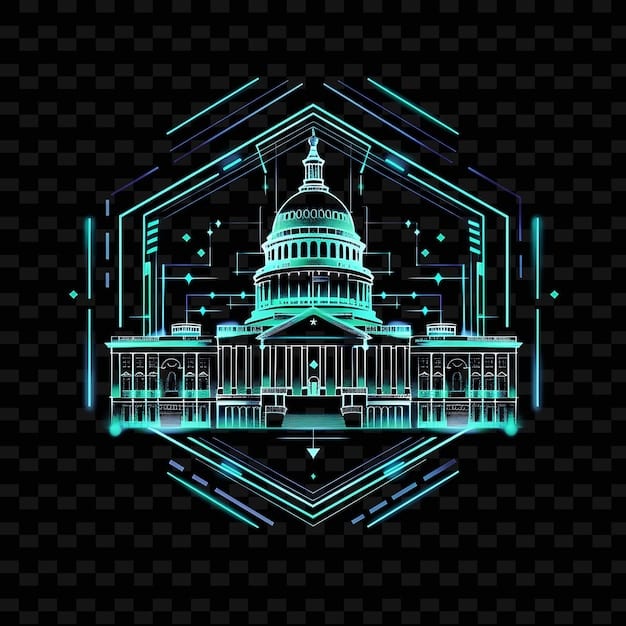US Crypto Regulation: Stablecoin Legislation in Detail

US Crypto Regulation: A Detailed Look at the Proposed Legislation for Stablecoins explores the evolving landscape of digital asset regulation in the United States, focusing on stablecoins and the potential impact of new legislation on the crypto market.
Navigating the complex world of **US Crypto Regulation: A Detailed Look at the Proposed Legislation for Stablecoins** can be challenging, especially with the rapid evolution of digital assets. This article breaks down the key aspects of proposed legislation for stablecoins, offering clarity and insights for both seasoned crypto enthusiasts and newcomers alike.
US Crypto Regulation: Stablecoins and the Legislative Landscape
The United States is actively shaping its regulatory approach to cryptocurrencies, with stablecoins emerging as a key area of focus. Proposed legislation aims to provide clarity and stability to the market, addressing concerns about consumer protection and financial stability. Understanding these regulations is crucial for anyone involved in the crypto space.
The Current State of Crypto Regulation in the US
Currently, there is no single, comprehensive federal law governing cryptocurrencies in the US. Instead, a patchwork of regulations exists at both the federal and state levels, creating uncertainty and challenges for businesses operating in the crypto industry.
- SEC’s Role: The Securities and Exchange Commission (SEC) has asserted its authority over certain cryptocurrencies, classifying them as securities and applying securities laws accordingly.
- CFTC’s Oversight: The Commodity Futures Trading Commission (CFTC) regulates cryptocurrency derivatives, such as futures contracts, and has also claimed jurisdiction over cryptocurrencies deemed commodities.
- State Regulations: Individual states have also enacted their own crypto regulations, ranging from licensing requirements for virtual currency businesses to consumer protection laws.
This fragmented regulatory landscape underscores the need for comprehensive federal legislation to provide clear rules and standards for the crypto industry.
The regulatory landscape is constantly evolving, influenced by technological advancements, market developments, and policy priorities. Proposed legislation seeks to address these challenges and establish a clear framework for the future of crypto in the US.
Understanding Stablecoins: A Primer
Stablecoins are a type of cryptocurrency designed to maintain a stable value relative to a reference asset, such as the US dollar. They aim to combine the benefits of cryptocurrencies – fast transactions, decentralization – with the stability of traditional currencies.

Types of Stablecoins
There are several types of stablecoins, each employing different mechanisms to maintain price stability:
- Fiat-Backed Stablecoins: These are backed by reserves of fiat currency, such as the US dollar, held in custody. Examples include Tether (USDT) and USD Coin (USDC).
- Crypto-Backed Stablecoins: These are backed by other cryptocurrencies, often with over-collateralization to provide a buffer against price volatility. Examples include Dai (DAI).
- Algorithmic Stablecoins: These rely on algorithms and smart contracts to adjust the supply of the stablecoin in response to changes in demand, aiming to maintain a stable price.
Each type of stablecoin has its own advantages and disadvantages, and the choice of which stablecoin to use depends on individual risk tolerance and preferences.
Stablecoins have become increasingly popular in the crypto ecosystem, serving as a bridge between traditional finance and decentralized finance (DeFi). However, their rapid growth has also raised concerns among regulators.
Key Provisions of Proposed Stablecoin Legislation
Several pieces of legislation have been proposed in the US Congress to regulate stablecoins. These proposals share common goals, such as establishing clear regulatory frameworks, protecting consumers, and mitigating systemic risks.
Reserve Requirements and Audits
Many proposed bills include provisions requiring stablecoin issuers to maintain reserves of high-quality liquid assets equal to the value of the outstanding stablecoins. These reserves would be subject to regular audits to ensure compliance.
Reserve requirements aim to ensure that stablecoin holders can redeem their stablecoins for the underlying asset at any time, reducing the risk of “bank runs” and maintaining confidence in the stablecoin.
Licensing and Supervision
Some proposals would require stablecoin issuers to obtain licenses from federal regulators, such as the Federal Reserve or the Office of the Comptroller of the Currency (OCC). These licenses would subject issuers to ongoing supervision and regulatory oversight.
Licensing requirements aim to ensure that stablecoin issuers meet certain standards for financial stability, risk management, and consumer protection.
Custodial Requirements
Proposed legislation may also address custodial requirements for stablecoin issuers, specifying how they must safeguard the assets backing the stablecoins. This could include requirements for segregation of assets, insurance coverage, and cybersecurity measures.
Custodial requirements aim to protect stablecoin holders from loss or theft of the underlying assets, enhancing the security and integrity of the stablecoin ecosystem.
The exact details of these provisions may vary depending on the specific bill, but the overall goal is to create a robust regulatory framework for stablecoins that promotes innovation while mitigating risks.
Potential Impact on the Crypto Market
The implementation of stablecoin legislation could have a significant impact on the broader crypto market, affecting everything from trading volumes to investment strategies.
Increased Regulatory Clarity
One of the primary benefits of stablecoin legislation is the potential for increased regulatory clarity. Clear rules and standards would provide a more predictable environment for businesses operating in the crypto industry, encouraging innovation and investment.
Regulatory clarity could also attract institutional investors who have been hesitant to enter the crypto market due to regulatory uncertainty.
Consumer Protection
Stablecoin legislation is expected to enhance consumer protection by requiring stablecoin issuers to maintain adequate reserves, undergo regular audits, and comply with licensing and supervisory requirements.
Stronger consumer protections could boost confidence in stablecoins and encourage wider adoption, benefiting both users and the industry as a whole.
Market Structure
The regulatory framework for stablecoins could also shape the structure of the crypto market, influencing the types of stablecoins that are available, the role of intermediaries, and the level of competition.

For example, strict reserve requirements could favor fiat-backed stablecoins over crypto-backed or algorithmic stablecoins, potentially leading to a concentration of market share among a few large issuers.
The future of stablecoins and their role in the crypto ecosystem will depend on the final form of the legislation and how it is implemented by regulators.
Challenges and Debates
The process of regulating stablecoins is not without its challenges. Policymakers must balance the need to protect consumers and financial stability with the desire to foster innovation and avoid stifling the growth of the crypto industry.
Defining “Stablecoin”
One challenge is defining what constitutes a “stablecoin.” The term can encompass a wide range of digital assets with varying degrees of stability and risk profiles. Policymakers must carefully consider how to define “stablecoin” in a way that is both precise and adaptable to future innovations.
Regulatory Jurisdiction
Another challenge is determining which regulatory agencies should have jurisdiction over stablecoins. The SEC, CFTC, Federal Reserve, and OCC all have expertise and interests in regulating different aspects of the crypto market. Coordinating regulatory oversight across these agencies is essential to avoid confusion and duplication.
Innovation vs. Regulation
Policymakers must also strike a balance between promoting innovation and protecting consumers and financial stability. Overly restrictive regulations could stifle innovation and drive crypto activity to other jurisdictions with more favorable regulatory environments.
- Finding the Right Balance: The key is to find a regulatory approach that is flexible enough to accommodate future innovations while still providing adequate safeguards against risk.
- International Coordination: Consider the global nature of cryptocurrencies and the need for international cooperation in regulating stablecoins.
Addressing these challenges will require careful consideration and collaboration among policymakers, regulators, and industry stakeholders.
The ongoing debates and discussions underscore the complexity of regulating stablecoins and the importance of getting it right.
Future Outlook for US Crypto Regulation
The future of **US Crypto Regulation: A Detailed Look at the Proposed Legislation for Stablecoins** is uncertain, but it is clear that regulators are paying close attention to the crypto market and are committed to developing a comprehensive regulatory framework. The next few years will be crucial in shaping the future of the industry in the United States.
Proposed Legislation: The potential passage of stablecoin legislation could mark a significant step forward in clarifying the legal and regulatory status of digital assets in the US.
Technological Advancements: The ongoing evolution of crypto technology will continue to challenge regulators and shape the regulatory landscape.
Market Adoption: Widespread adoption of cryptocurrencies could increase the pressure on policymakers to develop clear and comprehensive regulations.
| Key Point | Brief Description |
|---|---|
| 🔑 Regulation Goals | Consumer protection and financial stability are prioritized in new legislation. |
| 🏛️ Licensing | Federal licenses may be required for stablecoin issuers. |
| 🛡️ Reserve Requirements | Issuers may need to maintain high-quality liquid asset reserves. |
| 📈 Market Impact | Regulatory clarity could attract more institutional investment. |
Frequently Asked Questions
▼
A stablecoin is a type of cryptocurrency designed to maintain a stable value relative to a reference asset, such as the US dollar, aiming to offer stability with crypto benefits.
▼
Regulation is crucial for protecting consumers, preventing financial instability, and ensuring the integrity of the crypto market, allowing innovation to safely flourish.
▼
The main types include fiat-backed (like USDT), crypto-backed (like DAI), and algorithmic stablecoins, each maintaining stability differently.
▼
Agencies like the SEC, CFTC, and potentially the Federal Reserve may regulate stablecoins, depending on how they are structured and classified under law.
▼
New regulations could bring clarity, attract institutional investors, enhance consumer protection, and reshape the market structure for digital assets.
Conclusion
As the digital asset landscape continues to evolve, understanding **US Crypto Regulation: A Detailed Look at the Proposed Legislation for Stablecoins** will be crucial for anyone involved in the cryptocurrency market. The outcome of these regulatory efforts will shape the future of stablecoins and the broader crypto industry in the United States.





